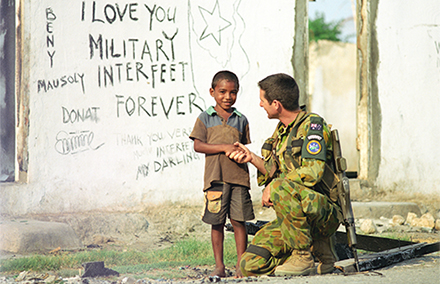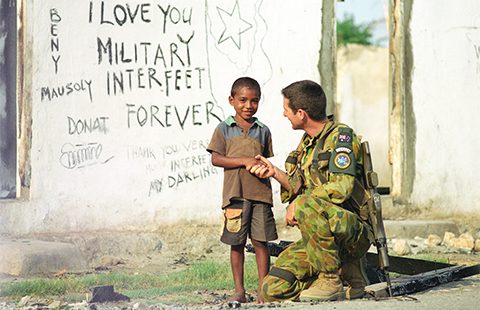
Photo: Department of Defence.
Australia’s 1999 mission to East Timor and lessons for today.
Sixteen years ago, Australia was on the precipice of a major confrontation with Indonesia.
A United Nations peacekeeping mission to the Indonesian province of Timor-Leste, which was pushing for independence, had the potential to put Canberra and Jakarta on a collision course.
Those tense moments turned into the birth of a new nation. It’s an extraordinary story that resonates today.
How Australia stumbled into that predicament and how it responded offers some salutary lessons about the uncertainty of our region, and the importance of military capabilities balanced with effective regional engagement.
In September 1999, as East Timor’s move for independence from Indonesia threatened to spiral out of control in a worsening security and humanitarian crisis, Australia was given a mandate by the United Nations, and the begrudging invitation from Indonesia to organise and lead a multinational peacekeeping mission to the troubled island.
The violence which wracked the country was sparked by militias opposed to East Timor’s overwhelming yes vote for independence, leading to key Timorese political figure Xanana Gusmao calling for a UN peacekeeping force.
That force, known as the International Force East Timor (INTERFET), involved some 20 countries, and included more than 5,000 Australians.
The deployment could have gone horribly wrong and understanding the implications for Australia’s relations with Indonesia and the wider region is critical as we seek to bolster regional security.
One trigger pulled, for instance, by a nervous soldier at a checkpoint in Dili, or one irresponsible act by an individual or group could have easily escalated into a bloody clash from which it would have been very difficult to extricate or back down.
Prime Minister at the time, John Howard, claims Australia’s involvement in the 1999 liberation of East Timor still resonates strongly with the Southeast Asian nation. ‘It directly led to the birth of a very small country whose people remain deeply grateful for what we did,’ he says.
The real security challenge for INTERFET was always going to be in the first week or so, and the stakes were high. There was a chance that militia groups might either continue to predate on the East Timorese, leading to combat with INTERFET forces, or that, through mischance or misjudgement, the Indonesian military (TNI) and INTERFET troops might clash.
The Indonesian Martial Law Commander, Lieutenant General Kiki Syahnakri, surprised those most critical of the Indonesian military by masterfully helping to avoid what could have degenerated into a vicious and ugly fight between neighbours. He understood the high stakes and the potentially devastating long term consequences of an armed clash leading to a more extensive conflict between Australia and Indonesia.
Additionally, the fast and powerful deployment of large numbers of combat troops, initially from Australia, New Zealand and the United Kingdom, was an emphatic deterrent to militia groups’ continued presence.
Thereafter, INTERFET could undertake a sort of ‘benign occupation’ of East Timor to restore confidence and, crucially, to allow the return and spread of United Nations and non-government organisation services.
The then Chief of the Australian Defence Force, Admiral Chris Barrie, was instrumental in cobbling together the multi-national coalition. He sent Air Marshall Doug Riding on a tour of the region mustering support for INTERFET.
In the meantime, key Defence policy adviser in Canberra, Hugh White, struggled to reconcile the policy contortions involved in trying to maintain stable and amicable relations with Indonesia in the face of ominous signs leading up to the September 20 ballot and afterwards, when looting and burning was widespread.
Hugh White was the Deputy Secretary Strategy in the Department of Defence at the time of the crisis. He witnessed much of the Australian government deliberations in Canberra as the force prepared to intervene in East Timor.
White argues that many people and organisations share responsibility for East Timor’s transition to independence, and that Australia’s proportion of that is ‘very small.’ But without question, while White may have a point in seeking to place Australia’s role in context, Australia’s contribution remained critical to the outcome.
East Timor’s President and former Prime Minister Xanana Gusmao, has a different perspective on how the intervention panned out. To him reconciliation, honouring those lost in the past and looking optimistically to the future is a hallmark of his approach. Mandela-like in his forgiveness and generosity, Gusmao’s remarkable posturing to stimulate reconciliation is one of the greatest indicators of hope for the young nation of East Timor.
In essence, the 1999 East Timor intervention led to a shift in perceptions of how Australia should see itself and what it could and should do to act decisively in its neighbourhood. For much of the time since those tumultuous days of September 1999, the Australian Defence Force has been preoccupied by threats in the Middle East.
But today security challenges are emerging aplenty in Australia’s neighbourhood: from territorial disputes in the South China Sea that threaten war between great powers to the resurgence of jihadists in our region.
Australia’s experience of mustering and managing the disparate INTERFET coalition and its engagement with regional security partners, serves as an important pointer of where Australian military engagement needs to remain a top priority.
John Blaxland is a senior fellow at the Strategic and Defence Studies Centre, Coral Bell School of Asia Pacific Affairs, the Australian National University.
His latest book, ‘East Timor Intervention: a retrospective on INTERFET’, will be launched by Lieutenant General Angus Campbell at ANU tonight.
 Facebook
Facebook  Twitter
Twitter  Soundcloud
Soundcloud  Youtube
Youtube  Rss
Rss 